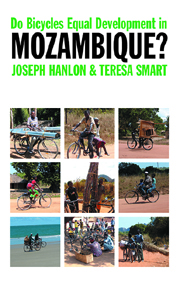Book contents
- Frontmatter
- Contents
- Acknowledgements
- The authors
- Money & measurements
- Abbreviations, acronyms & glossary
- Part I IS THERE DEVELOPMENT IN MOZAMBIQUE?
- Part II ACTORS & CONTEXT
- 9 Frelimo & the democratic one-party state
- 10 Corruption, rent-seeking, reform & a divided elite
- 11 Aid dependence & subservience: carrots & sticks
- 12 On the edge of the world
- Part III ALTERNATIVES & THE DEVELOPMENTAL STATE
- Appendix 1 Aid
- Appendix 2 Investment & other tables
- Bibliography
- Index
9 - Frelimo & the democratic one-party state
from Part II - ACTORS & CONTEXT
Published online by Cambridge University Press: 05 April 2013
- Frontmatter
- Contents
- Acknowledgements
- The authors
- Money & measurements
- Abbreviations, acronyms & glossary
- Part I IS THERE DEVELOPMENT IN MOZAMBIQUE?
- Part II ACTORS & CONTEXT
- 9 Frelimo & the democratic one-party state
- 10 Corruption, rent-seeking, reform & a divided elite
- 11 Aid dependence & subservience: carrots & sticks
- 12 On the edge of the world
- Part III ALTERNATIVES & THE DEVELOPMENTAL STATE
- Appendix 1 Aid
- Appendix 2 Investment & other tables
- Bibliography
- Index
Summary
When Sweden's Social Democratic Party lost the election in September 2006, it had been in power for all but nine years since 1932. Sweden is one of many democratic countries with a ‘natural’ party of government which is repeatedly elected over decades.
In many cases, a liberation movement becomes the dominant party, such as Congress in India and the PRI in Mexico (where PRI actually stands for the Institutionalised Revolutionary Party). Similarly, in southern Africa, it looks increasingly as if the African National Congress (ANC) in South Africa, Chama Cha Mapinduzi (CCM, Party of the Revolution) in Tanzania, and Frelimo in Mozambique are being seen by voters as the natural party of government.
The Swedish Social Democrats, Congress and the PRI were all eventually beaten at the polls. In what are sometimes called ‘predominant party states’, elections become a referendum on the ruling party – a vote for or against its continuation in power.
Democracy & the predominant party
Even in quite conservative US circles, predominant party states are sometimes seen as democratic. The ‘Polity IV’ project originated by Ted Gurr of the University of Maryland gives countries ‘democracy’ scores of 0 to 10 at various points in their history. By definition, the scores look to what it calls ‘Western democratic forms’. Of course, the US scores 10 since 1871.
- Type
- Chapter
- Information
- Do Bicycles Equal Development in Mozambique? , pp. 87 - 100Publisher: Boydell & BrewerPrint publication year: 2008



